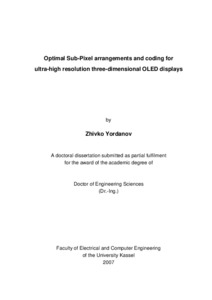| dc.date.accessioned | 2007-10-22T07:19:27Z | |
| dc.date.available | 2007-10-22T07:19:27Z | |
| dc.date.issued | 2007-10-22T07:19:27Z | |
| dc.identifier.uri | urn:nbn:de:hebis:34-2007102219478 | |
| dc.identifier.uri | http://hdl.handle.net/123456789/2007102219478 | |
| dc.format.extent | 3948120 bytes | |
| dc.format.mimetype | application/pdf | |
| dc.language.iso | eng | |
| dc.rights | Urheberrechtlich geschützt | |
| dc.rights.uri | https://rightsstatements.org/page/InC/1.0/ | |
| dc.subject | 3D | eng |
| dc.subject | autostereoscopic | eng |
| dc.subject | OLED | eng |
| dc.subject | Display | eng |
| dc.subject.ddc | 004 | |
| dc.title | Optimal Sub-Pixel arrangements and coding for ultra-high resolution three-dimensional OLED displays | eng |
| dc.type | Dissertation | |
| dcterms.abstract | Information display technology is a rapidly growing research and development field. Using state-of-the-art technology, optical resolution can be increased dramatically by organic light-emitting diode - since the light emitting layer is very thin, under 100nm. The main question is what pixel size is achievable technologically? The next generation of display will considers three-dimensional image display. In 2D , one is considering vertical and horizontal resolutions. In 3D or holographic images, there is another dimension – depth. The major requirement is the high resolution horizontal dimension in order to sustain the third dimension using special lenticular glass or barrier masks, separate views for each eye. The high-resolution 3D display offers hundreds of more different views of objects or landscape. OLEDs have potential to be a key technology for information displays in the future. The display technology presented in this work promises to bring into use bright colour 3D flat panel displays in a unique way.
Unlike the conventional TFT matrix, OLED displays have constant brightness and colour, independent from the viewing angle i.e. the observer's position in front of the screen. A sandwich (just 0.1 micron thick) of organic thin films between two conductors makes an OLE Display device. These special materials are named electroluminescent organic semi-conductors (or organic photoconductors (OPC )). When electrical current is applied, a bright light is emitted (electrophosphorescence) from the formed Organic Light-Emitting Diode. Usually for OLED an ITO layer is used as a transparent electrode. Such types of displays were the first for volume manufacture and only a few products are available in the market at present. The key challenges that OLED technology faces in the application areas are: producing high-quality white light achieving low manufacturing costs increasing efficiency and lifetime at high brightness. Looking towards the future, by combining OLED with specially constructed surface lenses and proper image management software it will be possible to achieve 3D images. | eng |
| dcterms.accessRights | open access | |
| dcterms.creator | Yordanov, Zhivko | |
| dc.contributor.corporatename | Kassel, Universität, FB 16, Elektrotechnik/Informatik | |
| dc.contributor.referee | Hentschke, Siegbert (Prof. Dr.-Ing.) | |
| dc.contributor.referee | Rangelow, Ivo W. (Prof. Dr.) | |
| dc.contributor.referee | Nedev, Assen (Prof.) | |
| dc.contributor.referee | Börcsök, Josef (Prof. Dr.-Ing.) | |
| dc.contributor.referee | Becker, Wolf-Jürgen (Prof. Dr.-Ing.) | |
| dc.subject.swd | Dreidimensionale Bildverarbeitung | ger |
| dc.subject.swd | Bildverbesserung | ger |
| dc.date.examination | 2007-07-27 | |

